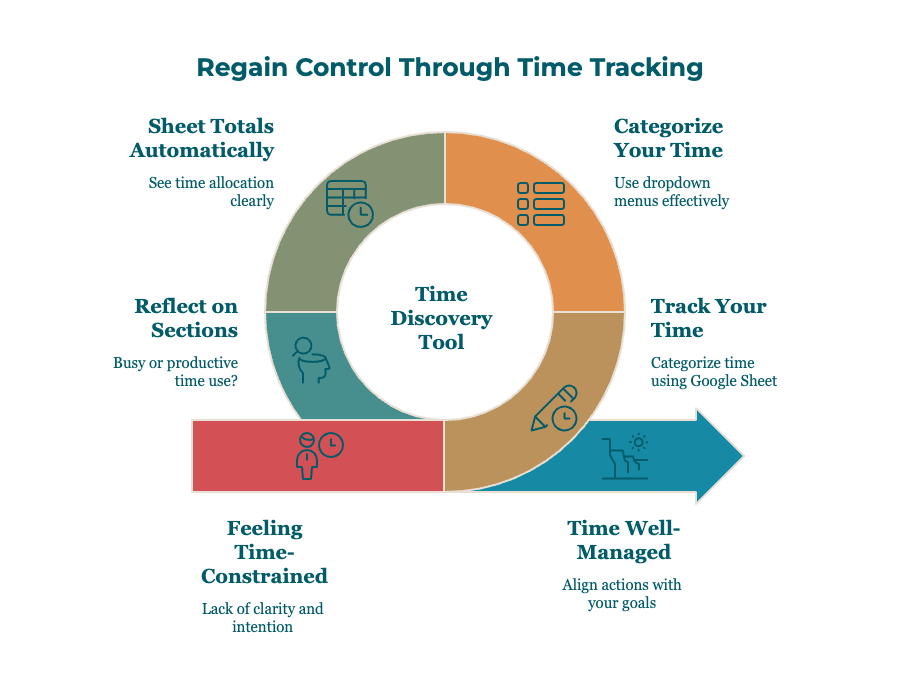
Are You Actually Too Busy—Or Just Stuck in Busy Mode?
Ever feel like there just aren’t enough hours in the day? Between work, family, and everything else life throws at you, it’s easy to feel like there’s no time left for yourself.
But here’s the real question: Are you truly too busy? Or is your time just being filled with obligations, distractions, and routines that aren’t actually moving you forward?
Many midlife women—especially those balancing careers, families, and personal commitments—spend their days running from one task to the next, constantly busy but rarely productive. We know we want to get stronger, feel more energetic, and prioritize our well-being… but our daily schedule doesn’t reflect those goals.
And that’s not your fault.
Because no one teaches us how to manage time in a way that aligns with what we actually want. Instead, we fall into habits, react to what’s urgent, and tell ourselves we’ll “get to it later.”
But later never comes.
The good news? There’s a simple way to figure out where your time is actually going—and how to take control of it.
The Busy vs. Productive Trap – Why We Never ‘Have Time’
Most women in midlife aren’t sitting around doing nothing. Your days are packed—managing work, supporting family, taking care of everything and everyone… except yourself.
It’s easy to say, “I just don’t have time for fitness or self-care.” But here’s the uncomfortable truth:
👉 Being busy is not the same as being productive.
Many of us spend our days reacting—putting out fires, responding to emails, running errands, saying “yes” to things out of obligation—without actually moving toward what we say we want.
And the worst part? We don’t even realize it’s happening.
Common “Busy Mode” Traps
You might be stuck in busy mode if you:
- Multitask constantly but feel like nothing actually gets done
- Say yes to everyone else’s needs before your own
- End the day exhausted but can’t point to anything meaningful you accomplished
- Feel like you’re “doing everything right” but not seeing results
🚨 Why This Matters: If your schedule is packed, but your goals aren’t being met, your time isn’t working for you—it’s working against you.
But don’t worry—I’m not here to make you feel bad about it. I’m here to change it.
And it all starts with clarity.

The Power of Clarity – Are Your Goals Strong Enough to Pull You Forward?
Here’s a hard truth: If your goals aren’t crystal clear and emotionally compelling, they will always take a backseat to “busy work.”
Most women say things like:
❌ “I want to get stronger.” (Too vague—stronger how? Why?)
❌ “I should eat better.” (No real connection to their life, just a generic ‘should’)
❌ “I need to start exercising.” (Lacks specificity or motivation—what kind of exercise? Why?)
❌ “My doctor is going to kill me if I haven’t lost weight at my next appointment.” (Fear-driven, but doesn’t provide a clear path forward—especially if they’ve tried before and seen no change)
❌ “I don’t want to end up like my parents.” (A valid fear, but too broad—what specific steps will prevent that?)
💡 Why These Don’t Work:
- They’re too vague. There’s no clear action or emotional connection.
- They’re often based on guilt or external pressure. Fear alone doesn’t create long-term change.
- They focus on what they ‘should’ do instead of what they truly want to achieve.
Instead, let’s make these goals more powerful and specific:
✅ “I want to lift my grandkids without back pain by the holidays.” (Specific + tied to real life)
✅ “I want to wake up with more energy so I’m not relying on caffeine to get through the day.” (Addresses fatigue + provides a reason for change)
✅ “I want to stop feeling stiff every morning, so I’ll commit to 10 minutes of movement before breakfast.” (Small, realistic, and action-oriented)
✅ “I want to feel confident walking into my next doctor’s appointment, knowing I’ve made real progress.” (Shifts from fear to empowerment—progress on their own terms, not just the scale)
✅ “I want to lower my risk of diabetes so I can stay active and independent as I age.” (Health-focused, not weight-focused, and tied to a deep motivation)
✅ “I want to reduce my reliance on medications by improving my habits in a way that supports my health.” (Empowering but avoids giving medical advice—puts focus on personal action)
✅ “I want to finally put myself on my own priority list without feeling guilty about it.” (Addresses the emotional barriers many midlife women face around self-care)

Where Is Your Time Really Going? (Introducing my Time Discovery Tool)
If you feel like you don’t have time, tracking it is the first step to getting it back. I’ve created a resource that not only helps you track your time, but analyze it! Here’s what you’ll do once you dowload my tool.
✅ Track your time for at least a week (ideally two).
✅ Use the dropdown menus in the Google Sheet to categorize your time.
✅ The sheet totals everything for you—so you can see exactly how much time goes where.
✅ Reflect on each section: Was this time busy or productive?
🚨 Heads-Up: Self-awareness can be hard. Sometimes, tracking your time makes you realize uncomfortable things—like how much time is wasted on things that don’t really matter.
This isn’t about guilt. It’s about taking back control.
Conclusion

Your Time = Your Life. Make It Count.
If you feel like you never have time, the real issue isn’t time—it’s clarity and intention.
By tracking your time, identifying wasted moments, and redirecting even 15-30 minutes a day, you can start aligning your actions with your goals.
🎯 Ready to take back control?
📥 Download the Time Discovery Tool now and start using your time in a way that actually serves you.

